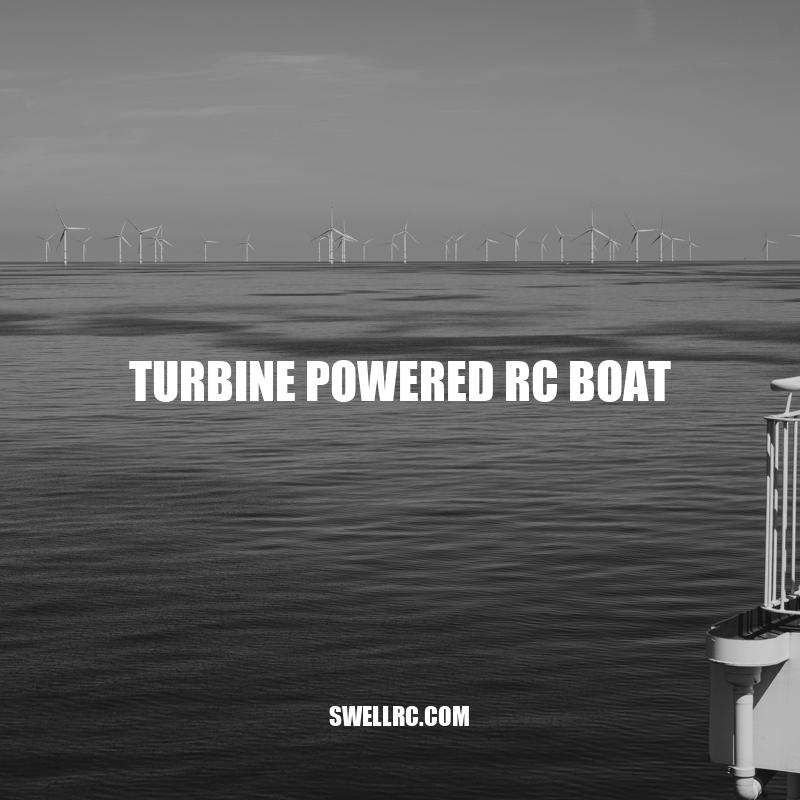Turbine Powered RC Boats: High-Speed Thrills and Top Maintenance Tips
Turbine powered RC boats are a new breed of remote control boats that offer unparalleled speed and power. These boats utilize a turbine engine to generate energy, providing a level of performance much higher than typical electric or gas models. As a result, they are a popular choice among experienced RC boat enthusiasts looking for a greater challenge. However, turbine engines are also more expensive and require more upkeep than other types of engines, so they may not be the best choice for beginners. Still, their ability to reach speeds of up to 100 mph or more makes them a thrilling choice for those who crave speed and competition. In this article, we will examine the basics of turbine powered RC boats, including how they work, how to choose the right engine, and how to maintain and operate them safely.
Understanding Turbine Engines in RC Boats
Turbine engines work by using the airflow to create power. They are commonly used in jet planes and helicopters, but they are also popular for RC boats because they offer a higher level of speed and performance compared to other engines. Below are some important factors to consider when understanding turbine engines in RC boats:
– Turbine engines are more powerful than other types of engines, leading to higher speeds and greater performance.
– The engines typically use a fuel mix of kerosene and oil.
– They are generally more expensive than other engines.
– Turbine engines have a unique sound that makes them distinguishable from other engines.
– Some popular brands of turbine engines for RC boats include Jetcat and Wren.
It’s important to note that turbine engines can be very loud, which can be disruptive to others in the area, especially if you’re operating the boat in a public space. Additionally, these engines can be very expensive, so you will want to take extra care when using them to avoid damage or accidents. If you’re considering using a turbine engine for your RC boat, there are many helpful resources available to help you understand how they work and what to expect. For instance, the RC Groups forum has a dedicated section for turbine engines in RC vehicles, with many experienced enthusiasts offering tips and advice on how to use these powerful engines.
What kind of engines are in RC jets?
RC jet engines mainly use turbine engines that work the same way as full-scale jet engines. These turbines consist of three sections: the compressor, the combustion chamber, and the turbine. The fuel used is typically ‘Jet A1’. For further information, you can visit RC hobby websites such as Horizon Hobby or Motion RC.
Choosing the right turbine engine for your RC boat is essential to achieve optimal performance. There are several factors to consider when selecting a turbine engine, such as horsepower, torque, fuel consumption rate, weight, and price.
Here are some popular turbine engine models and their specifications:
- Jetcat P220 RXi: 47.2 HP, 148 N-m torque, 600-1280 ml/min fuel consumption, 1.25 kg weight, $6,500 price.
- Wren MW44: 12 HP, 48 N-m torque, 338 ml/min fuel consumption, 1.05 kg weight, $3,500 price.
- Turbine Solutions TS18H-1B: 4.5 HP, 10 N-m torque, 120 ml/min fuel consumption, 0.4 kg weight, $2,000 price.
It’s essential to do thorough research to find the best turbine engine that suits your RC boat. You can also ask for recommendations in online forums or from experienced enthusiasts. Moreover, it’s important to note that turbine engines are more expensive than other engines, and maintenance fees can add up over time, so be sure to factor in the cost when making your decision.
When searching for a turbine engine for your RC boat, keep in mind that some brands may offer better quality or performance than others. It’s important to read reviews and compare specifications before making your purchase.
Additionally, make sure the engine you choose is compatible with the size and weight of your boat. A larger boat may require a stronger engine, while a smaller boat may need a more lightweight option.
Overall, investing in a high-quality turbine engine can greatly enhance the speed and performance of your RC boat. Do your research, compare options, and choose the best engine for your needs and budget.
Maintaining Your Turbine Engine for Optimal Performance
Maintaining your turbine engine is crucial to keep it running smoothly and efficiently. Here are some tips to keep your engine in good shape:
- Regular Cleaning: Clean the inside of the turbine engine and the surrounding area using compressed air and a clean cloth. Dirt and debris can collect in the engine and cause damage.
- Check for Loose Fittings: Make sure all fittings are tight to avoid fuel or air leaks, which can affect the engine’s performance.
- Lubrication: Maintain the engine’s internal components by regularly lubricating them to prevent rust and prolong parts’ lifespan.
- Replace Worn-Out Parts: Keep spare parts on hand and replace them if you notice any damage or wear and tear on the engine.
Turbine engines are generally more durable than other types of engines; however, they still require regular maintenance to function correctly. If you are not confident in performing maintenance tasks yourself, take your engine to an experienced technician who can help you.
Some online shops offer a wide range of spare parts and accessories for turbine powered RC boats. One such shop is www.turbines-rc.com, which sells top-quality parts and accessories such as fuel tanks, engine mounts, and exhaust pipes that are compatible with popular turbine engine brands such as JetCat and Wren. Buying spare parts and accessories from trusted sellers is a great way to ensure the longevity of your RC boat and engine.
How can you increase the performance and efficiency of a gas turbine?
To increase the performance and efficiency of a gas turbine, one effective approach is to tackle high temperatures. This is because the less dense the air, the lower the mass flow, and therefore, the lower the efficiency. To counter this, gas turbines can utilize methods such as turbine blade cooling, compressor intercooling, and inlet air cooling. By enhancing the density of the air, these methods can help increase the efficiency of the gas turbine. Visit manufacturer websites such as GE and Siemens for more information on products that can improve gas turbine performance.
Safety Tips for Operating a Turbine Powered RC Boat
While turbine powered RC boats are incredibly fun to use, it’s important to take safety precautions to prevent accidents. Here are some safety tips to keep in mind when operating a turbine powered RC boat:
- Wear Protective Gear: Always wear protective gear, such as gloves and goggles when handling the engine or boat. This gear can protect you from fuel spillage and burns.
- Handle Fuel Carefully: Fuel used in turbine engines is highly flammable, so handle it carefully. Avoid smoking or using any open flame around fuel.
- Clear the Area: Make sure the area where you are running your boat is free from obstructions such as people, pets, or boats.
- Keep Fuel Tank at a Safe Distance: Keep the fuel tank at a safe distance from the engine. Don’t tilt the fuel tank when refilling it to avoid spillage.
- Keep Hands Clear of the Engine: Never put your hands inside the engine or reach near the turbine blades when the engine is running.
- Shut Off the Engine: Shut off the engine and take it to a safe place immediately when you notice any issues with the boat’s performance or if you smell fuel leakage.
It’s important to exercise caution and safety measures to prevent accidents and injuries from occurring. By following these safety tips, you can have an exciting and safe turbine powered RC boat experience.
If you’re new to the world of RC boats, it’s recommended to take some time to learn about the hobby and its safety considerations before diving into using a turbine powered boat. Some great resources to learn more include RC Boats Forum, rcboatguide.com, and modelingmadness.com. By learning about the hobby, you can safely enjoy the thrill of racing your RC boat with peace of mind.
How does a RC turbine work?
RC turbines work on the same principle as full-sized turbine engines. The engine sucks in air, which is then compressed, mixed with fuel, and ignited. This creates a high-pressure stream of exhaust gases that is directed out through a nozzle to create thrust. RC turbine engines are often used in model airplanes and helicopters for their power and efficiency. To learn more about how RC turbines work and to explore different models, check out websites such as HorizonHobby.com or MotionRC.com.
Conclusion
Turbine powered RC boats offer a thrilling and exciting experience for beginners and advanced hobbyists alike. They are a great way to challenge your skills and enjoy high-speed racing on the water. However, it’s important to understand the risks associated with operating a turbine engine and take necessary safety precautions to prevent accidents and injuries.
Choosing the right engine and maintaining it properly are also critical aspects to ensure optimal performance and longevity of the boat. By following our tips and recommendations, you can have a smooth and enjoyable experience with your turbine powered RC boat.
As the popularity of RC boats as a hobby continues to grow, more people are trying out this adventurous sport. We hope this article has provided you with valuable insights into turbine powered RC boats, their benefits, and important considerations to keep in mind.
Remember, safety always comes first when operating a turbine powered RC boat, so don’t skip any safety measures or overlook the importance of proper maintenance and engine choices. With the right skills, tools, and knowledge, you can enjoy the thrill of the race with peace of mind. So, let the adventure begin!



